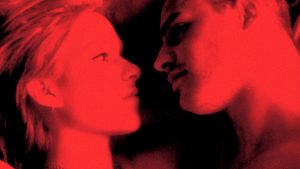Run Lola Run isn’t your typical heist film. It’s a vibrant, 90’s gamification experiment in cinema storytelling, where the protagonist, Lola, races against time to save her boyfriend, Manni. The film’s discontinuous style, blending film, animation, and polaroid photography, could easily become chaotic. Yet, the director, Tom Tykwer, masterfully maintains coherence and momentum, keeping us on the edge of our seats through three iterations of the same 20-minute sprint.
One key to this coherence is the repetition of Lola’s quest and driving motivation to obtain $100,000. While the broader narrative shifts with each “run,” familiar elements ground us. We see Lola repeatedly leaving her apartment (in animation) and navigating the same Berlin streets (in film), encountering recurring characters that aren’t essential to the main plot, like the older woman with her baby and the nuns getting in her way. This repetition creates a rhythmic structure, allowing the audience to anticipate certain events while remaining alert for deviations.

But repetition doesn’t mean stagnation. Tykwer cleverly uses these recurring encounters to explore the butterfly effect. Each time Lola interacts with someone, even in passing, their lives, and ultimately hers, are subtly altered. A bumped shoulder here, a different reaction there, can lead to vastly different outcomes, visually conveyed through rapid-fire flash-forwards of their potential futures as Polaroid still photography.
Driving this narrative is Lola’s fierce determination to save Manni, a desire born from love and a questioning of her own devotion. This propulsive energy fuels the frantic editing, mirroring her racing heartbeat and the ticking clock. The urgency is palpable, heightened by the recurring motif of clocks and timepieces.

Tykwer manipulates time not just through editing, but also through pacing. The first run feels incredibly compressed, bombarding us with information and new faces. This mirrors Lola’s initial panic and the audience’s own disorientation. As the film progresses, time seems to stretch and contract. The final run, with Lola’s casino gamble, feels almost suspended in time, building suspense as the roulette wheel spins.
Furthermore, the intimate scenes between Lola and Manni, bathed in red light, provide a crucial break from the frenetic pace. These moments, detached from the external chaos, offer a glimpse into their emotional connection, reminding us of the stakes involved.

Run Lola Run is a testament to the power of cinematic storytelling. Through innovative editing, visual motifs, and a compelling narrative, Tykwer crafts a film that is both thrilling and thought-provoking, leaving us to ponder the nature of time, chance, and the choices that shape our lives.